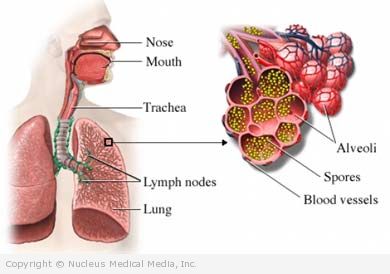Anthrax – Definition
Anthrax is an infection. It is caused by bacteria and can be life-threatening. The disease is more common in hoofed animals, like cattle and goats. In rare cases, people can contract anthrax from infected animals or anthrax spores. The bacteria produce spores that can survive in the environment for decades.
There are three forms of human anthrax, depending on where spores enter the body:
- Inhalated — from breathing airborne spores into the lungs (about 5% of cases)
- Cutaneous (or skin) — due to spores entering a cut or break in the skin (about 95% of cases)
- Gastrointestinal — from ingesting spores in raw or undercooked food (extremely rare)
Anthrax – Causes
Bacillus anthracis cause anthrax. Anthrax occurs after exposure to:
- Infected animals
- Infected animal products
- Spores
Once in the body, the spores germinate. This means they change to active bacteria. They multiply and release toxins. This leads to swelling, bleeding, and tissue death. All forms of anthrax can cause death. Only 10%-20% of untreated cutaneous cases are lethal. Inhalation anthrax is highly lethal once symptoms develop. Death can occur within a few days.
Anthrax – Risk Factors
Risk factors for anthrax include the following:
- Working in a laboratory with Bacillus anthracis
- Working with anthrax-infected animals or their products (eg, at a farm, leather tannery, woolery, veterinary clinic)
- Exposure to criminal acts or biologic terrorism
Anthrax – Symptoms
These usually start within a few days of exposure. They vary depending on the type of disease.
Inhalation anthrax symptoms occur in stages over several days and include:
- Cold or flu symptoms:
- Cough
- Fatigue
- Weakness
- Fever
- Chills
- Headache
- Muscle aches
- Sometimes a brief period of seeming recovery, followed by rapid onset of:
- Severe difficulty breathing
- Chest pain
- Sweating
- Shock
- Delirium
- Death
Cutaneous or skin symptoms occur in stages:
- Raised bump, like an insect bite, that is itchy and round
- Raised area opens, forming an ulcer with a black area in the center and producing drainage of clear or pinkish fluid
- Swelling around the wound
- Swollen, painful lymph nodes
Gastrointestinal lesions can occur in:
- Mouth and throat:
- Sores in the mouth or esophagus
- Swelling in throat
- Swollen lymph nodes
- Sore throat
- Intestines:
- Nausea
- Vomiting
- Fever
- Abdominal pain
- Bloody diarrhea
Anthrax – Diagnosis
The doctor will ask about your symptoms and medical history. The doctor will look for a possible source of exposure. A physical exam will be done.
Test may include:
- Chest x-ray for inhalation anthrax
- Culture of wounds, mucosal membranes, and body fluids to check for bacteria
- Blood test to detect antibodies to anthrax
Anthrax – Treatment
It is important to start antibiotics early. Any delay greatly increases the risk of death in cases of inhalation anthrax. Treatment is begun by IV. This is followed by oral antibiotics. You may need to take antibiotics for many weeks. Skin lesions are carefully cleaned. They are dressed with bandages.
Medications
You may be prescribed:
- Ciprofloxacin (Cipro)
- Penicillin
- Doxycycline
Public Health Measures
Finding the source of the anthrax is very important. Public health officials will check places where a patient lives and works. Contaminated surfaces should be disinfected. Other people who may have been exposed will be tested. They may be given antibiotics.
Anthrax – Prevention
It is difficult to tell if you have been exposed. Anthrax is colorless and has no smell or taste. Seek medical care if you suspect that you have had contact with anthrax. Antibiotics may be able to prevent infection following exposure. There is a vaccine to prevent anthrax. It requires multiple shots and is only partially effective. The vaccine is not recommended for the general population. It is routinely given to military personnel.
Strategies to prevent exposure to anthrax include:
- Avoid contact with infected animals or animal products.
- Do not touch fluid draining from an anthrax wound.
- Handle suspicious mail properly:
- Do not open mail from an unknown source.
- Do not shake packages.
- Do not smell or taste contents.
- Put the parcel down and immediately wash your hands with soap and warm water.
- Call local law enforcement.

